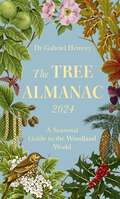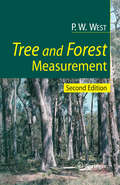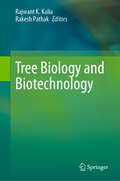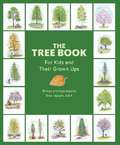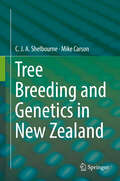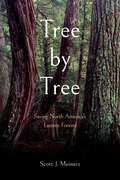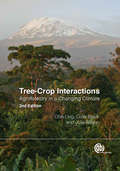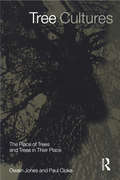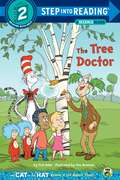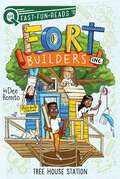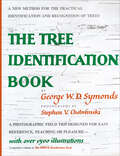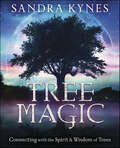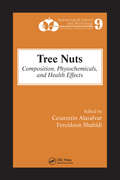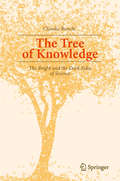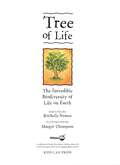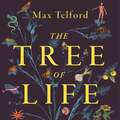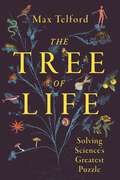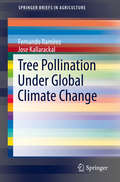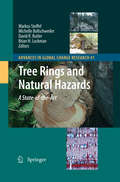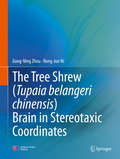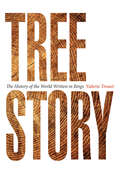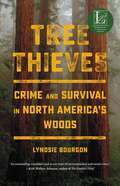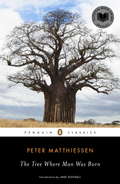- Table View
- List View
The Tree Almanac 2024: A Seasonal Guide to the Woodland World
by Dr. Gabriel HemeryA wondrous seasonal journey through Britain and Ireland's trees.Uncover the majesty and minutiae of the arboreal world in forest scientist Dr Gabriel Hemery's illustrated month-by-month guide - including tree folklore and traditions, recipes and crafts, key dates, curiosities to spot, notes on wildlife and scientific marvels from the trees that surround us.From bare branches to budbursts, the first leaves to the first blossom and the great autumn colour-change, the Tree Almanac celebrates with joyous detail all that trees give us - whether ancient or urban - and inspires us to reconnect with nature. Foreword by Tracy Chevalier.
Tree and Forest Measurement
by Phil WestForests must be measured, if they are to be managed and conserved properly. This book describes the principles of modern forest measurement, whether using simple, hand-held equipment or sophisticated satellite imagery. Written in a straightforward style, it will be understood by everyone who works with forests, from the professional forester to the layperson. It describes how and why forests are measured and the basis of the science behind the measurements taken.
Tree Biology and Biotechnology
by Rajwant K. Kalia Rakesh PathakThis edited book aims to bring out a comprehensive collection of information on tree biology, breeding, improvement, genetics, and biotechnology. The focus of this book is to address the status of tree biology research through biotechnological, physiological, pathological, and entomological aspects. Trees are dominant and perennial species found in several ecosystems. They are the only piece of infrastructure that gains value over time. Their economic relevance is well known in terms of the production of food, feed, fodder, fuel, timber, and other products. Trees are well-known habitats for different organisms. They also deliver various ecosystem services, including temperature regulation, mitigation of soil erosion, and managing and filtering rainwater. Tree species are versatile and are capable of providing livelihood security to people, besides several other advantages. In the era of high population growth and increasing pressure on agricultural systems, efficient management of tree resources is the need of the time. Therefore, it is essential to understand tree biology, breeding, and improvement. This book comprises information on various aspects of tree breeding, biology, genetics, and research in the improvement of tree species. Applications of tissue culture, biotechnological approaches, tree health management, insect pest management, and nutrient recycling have been covered in the book, along with some chapters on case studies from Rajasthan and Africa. This book is a useful read for agricultural students, researchers, teachers, and professionals interested in the fields of agroforestry, horticulture, silviculture, and tree improvement.
The Tree Book For Kids and Their Grown-ups
by Gina IngogliaThe birds, the bees, the flowers and the…TREES! How do trees grow? Why do leaves change? What kind of tree is that? The Brooklyn Botanic Garden’s guide answers all kids’ and their parents' tree-related questions in an easy-to-understand way. It features 33 different trees that grow in North America, from rural Georgia to the streets of New York City to the California suburbs.
Tree Breeding and Genetics in New Zealand
by C.J.A. Shelbourne Mike CarsonDothistroma pini changed New Zealand commercial forestry dramatically. Tree breeding became concentrated on a very few species and development of selection methods and breeding strategies changed in response to the new challenges. Tree-Breeding and Genetics in New Zealand provides a critical historical account of the work on provenance research and tree breeding, often with the wisdom of hindsight, and it tracks the development of breeding strategy, especially for P. radiata, Douglas-fir and the most important eucalypt species, E. regnans, E. fastigata and E. nitens. The book is a compendium of abstracts and summaries of all publications and reports on tree improvement in New Zealand since the early 1950s, with added critical comment by the author on much of the work. It is intended for other tree breeders internationally, for interested NZ foresters and for graduate students studying genetics and tree breeding.
Tree by Tree: Saving North America's Eastern Forests
by Scott J. MeinersTree by Tree is a warning and a toolkit for the future of forest recovery. Scott J. Meiners investigates the critical biological threats endangering tree species native to the forests of eastern North America, providing a needed focus on this plight. Meiners suggests that if we are to save our forests, the first step is to recognize the threats in front of us. Meiners focuses on five familiar trees—the American elm, the American chestnut, the eastern hemlock, the white ash, and the sugar maple—and shares why they matter economically, ecologically, and culturally. From outbreaks of Dutch elm disease to infestations of emerald ash borers, Meiners highlights the challenges that have led or will lead to the disappearance of these trees from forests. In doing so, he shows us how diversity loss often disrupts intricately balanced ecosystems and how vital it is that we pay more attention to massive changes in forest composition.With practical steps for the conservation of native tree species, Tree by Tree offers the inspiration and insights we need to begin saving our forests.
Tree-Crop Interactions: Agroforestry in a Changing Climate
by Dennis DennisThis new edition provides an update on the considerable amount of evidence on tree-crop interactions which has accumulated during the last two decades, especially on the more complex multi-strata agroforestry systems, which are typical of the humid tropics. In addition three new chapters have been added to describe the new advances in the relationship between climate change adaptation, rural development and how trees and agroforestry will contribute to a likely reduction in vulnerability to climate change in developing countries
Tree Cultures: The Place of Trees and Trees in Their Place
by Paul Cloke Owain JonesThe relationship between nature and culture has become a popular focus in social science, but there have been few grounded accounts of trees. Providing shelter, fuel, food and tools, trees have played a vital role in human life from the earliest times, but their role in symbolic expression has been largely overlooked. For example, trees are often used to express nationalistic feelings. Germans drew heavily on tree and forest imagery in nation-building, and the idea of 'hearts of oak' has been central to concepts of English identity. Classic scenes of ghoulish trees coming to life and forests closing in on unsuspecting passers-by commonly feature in the media. In other instances, trees are used to represent paradisical landscapes and symbolize the ideologies of conservation and concern for nature. Offering new theoretical ideas, this book looks at trees as agents that co-constitute places and cultures in relationship with human agency. What happens when trees connect with human labour, technology, retail and consumption systems? What are the ethical dimensions of these connections? The authors discuss how trees can affect and even define notions of place, and the ways that particular places are recognized culturally. Working trees, companion trees, wild trees and collected or conserved trees are considered in relation to the dynamic politics of conservation and development that affect the values given to trees in the contemporary world. Building on the growing field of landscape study, this book offers rich insights into the symbolic and practical roles of trees. It will be vital reading for anyone interested in the anthropology of landscape, forestry, conservation and development, and for those concerned with the social science of nature.
The Tree Doctor (Step into Reading)
by Tom Brannon Tish RabeWhen Sally and Nick's maple tree won't grow, the Cat in the Hat knows who to call: Dr. Twiggles, who suggests they inspect its roots. A trip underground in the Thinga-ma-jigger is undertaken, and sure enough, the maple tree needs water (which Things One and Two procure in ridiculous overabundance) and sun (which the Cat supplements with a Brighta-ma-lighter). But as for getting syrup from the young sapling? That will take some 40 years! Written specifically for children learning how to read with help, this Step into Reading book is based on an episode of the hit PBS Kids' TV show The Cat in the Hat Knows a Lot About That! It is perfect for springtime reading, Earth and Arbor Day celebrations--and yes, even pancake breakfasts!
Tree House Station: A QUIX Book (Fort Builders Inc. #4)
by Dee RomitoThe kids of Fort Builders, Inc., hunt for the perfect treehouse tree in the fourth story in the fun-to-read Aladdin QUIX chapter book series that&’s perfect for emerging readers!Caleb and the rest of the Fort Builders, Inc. group feel like it&’s finally time to have their own dedicated workspace! Their big idea? A fort treehouse! But finding the perfect tree for their unique fort is a little tougher than they thought...
The Tree Identification Book
by George W. SymondsThe classic easy-reference field guide with more than 1500 photographs: &“An almost foolproof practical reference book.&” —Kirkus Reviews (starred review) This useful book for botanists, horticulturists, and nature lovers is made up of two parts: Pictorial Keys and Master Pages. The Keys are designed for easy visual comparison of details that look alike, narrowing the identification of a tree to one of a small group—the family or genus. Then, in the Master Pages, the species of the tree is determined, with similar details placed together to highlight differences within the family group, thus eliminating all other possibilities. All of the more than 1500 photographs were made specifically for use in this book and were taken either in the field or of carefully collected specimens. Where possible, details such as leaves, fruit, etc., appear in actual size, or in the same scale.
Tree Magic: Connecting with the Spirit & Wisdom of Trees
by Sandra Kynes60+ Trees to Deepen Your Connection with NatureTrees provide a gateway into a wider world of spirit and magic. This book helps you explore their timeless mysteries and work with their unique energy. Popular author Sandra Kynes shows you how to connect with the wonder of the forest and develop a deeper understanding and relationship with trees.This practical guide introduces you to more than sixty varieties of trees, providing illustrations, lore, botanical and historical information, ritual and magical uses, associated deities, and more. Sandra offers an abundance of resources, including correspondence charts, tree and rune calendars, and the Celtic ogham. Learn about tools from the woods like staffs, wands, and wreaths. Discover what items you can use to connect to a particular tree when it's not available in your area. Whether you're looking for a tree aligned with Venus or one to aid your divination, Tree Magic is the ideal resource to bring the magic, spirit, and wisdom of trees into your life.
Tree Nuts: Composition, Phytochemicals, and Health Effects (Nutraceutical Science and Technology)
by Fereidoon Shahidi Cesarettin AlasalvarNuts have been long perceived as a high-fat, high-calorie food, best avoided or consumed in moderation. However, research is showing that tree nuts are cholesterol-free and contain unsaturated fats which can help lower the risk of heart disease. Nuts also provide essential nutrients such as magnesium, chromium, zinc, and manganese. Like all plant foods they are high in fiber and phytochemicals. This book examines ten popular tree nuts and describes each nut's compositional characteristics, lipid characteristics, effects of consumption on serum lipid profiles, as well as their phytochemicals and role disease prevention. In addition the book covers allergens and uses for non-edible parts.
The Tree of Knowledge
by Claudio RonchiWhether considered a divine gift or a Promethean conquest, science has indisputably and indelibly marked the course of human history. A product of the intellectual elite, but always nourished by the many fruits of its applications, science appears today to be a perfect system, whose laws and discoveries guide all human activities. Yet the foundations of its authority remain an open question, entailing disquieting aspects that are also to be identified in modern science. Furthermore it is seen to be exerting an increasing power over mankind. Readers are invited to follow an itinerary through the history of science, a voyage which, in the end, enables them to catch a glimpse of two divergent futures: One in which science accelerates the downfall of Homo sapiens, and another in which it helps our species to engage in a new and positive adventure, whose outcome nobody can know.
Tree of Life: The Incredible Biodiversity Of Life On Earth (Citizenkid Ser.)
by Rochelle StraussIf every known species on Earth were a leaf on a tree, that tree would have 1 750 000 leaves. Since humans count for just one leaf on the tree, we have a lot to learn about the millions of other forms of life with which we share the world. A dazzlingly illustrated and child-friendly introduction to biodiversity, Tree of Life shows how living things are classified into five kingdoms - and how each has much to tell us about all aspects of life on our planet. Tree of Life is part of Citizen Kid: A collection of books that inform children about the world and inspire them to be better global citizens.
The Tree of Life: Solving Science's Greatest Puzzle
by Max Telford'A DELIGHT' HENRY GEE'BEAUTIFUL' THOMAS HALLIDAYWhere do we come from and how did we get here?Come time-travelling through the history of every species that has ever lived with Professor Max Telford.A four-billion-year journey through the evolution of our planet, The Tree of Life tells the fascinating story of the gigantic family tree that records the relationships between every living thing - from humans, fish and butterflies to oak trees, mushrooms and even bacteria.Understanding how the amazing diversity of life on earth came to be is one of the greatest puzzles in biology. And this book, full of vivid and fascinating stories, takes you right inside: learn why grey wolves are more closely related to whales than to Tasmanian wolves; how geological change and environmental catastrophe left their marks on the genome; why we don't have tails but we are the only species with chins; and follow individual scientists down winding evolutionary byways and occasional dead ends in their attempts to solve this greatest of all puzzles. Along the way, we'll see how, far from being a dry representation of the dead, the tree of life is a living thing which constantly alters our perspective on the past, present and future of life on earth.From Darwin's early sketches to the vast computer generated diagrams scientists are building today, The Tree of Life explains how we can know our family tree at all and tells the epic history of the various ways it's possible to be a living thing. This is our own very personal story that began with the tiny ancestor of all life billions of years ago and ends with you and me.
The Tree of Life: Solving Science's Greatest Puzzle
by Max Telford'A DELIGHT' HENRY GEE'BEAUTIFUL' THOMAS HALLIDAYWhere do we come from and how did we get here?Come time-travelling through the history of every species that has ever lived with Professor Max Telford.A four-billion-year journey through the evolution of our planet, The Tree of Life tells the fascinating story of the gigantic family tree that records the relationships between every living thing - from humans, fish and butterflies to oak trees, mushrooms and even bacteria.Understanding how the amazing diversity of life on earth came to be is one of the greatest puzzles in biology. And this book, full of vivid and fascinating stories, takes you right inside: learn why grey wolves are more closely related to whales than to Tasmanian wolves; how geological change and environmental catastrophe left their marks on the genome; why we don't have tails but we are the only species with chins; and follow individual scientists down winding evolutionary byways and occasional dead ends in their attempts to solve this greatest of all puzzles. Along the way, we'll see how, far from being a dry representation of the dead, the tree of life is a living thing which constantly alters our perspective on the past, present and future of life on earth.From Darwin's early sketches to the vast computer generated diagrams scientists are building today, The Tree of Life explains how we can know our family tree at all and tells the epic history of the various ways it's possible to be a living thing. This is our own very personal story that began with the tiny ancestor of all life billions of years ago and ends with you and me.
Tree of Origin: What Primate Behavior Can Tell Us about Human Social Evolution
by F. B. WaalHow did we become the linguistic, cultured, and hugely successful apes that we are? Our closest relatives--the other mentally complex and socially skilled primates--offer tantalizing clues. In Tree of Origin nine of the world's top primate experts read these clues and compose the most extensive picture to date of what the behavior of monkeys and apes can tell us about our own evolution as a species. It has been nearly fifteen years since a single volume addressed the issue of human evolution from a primate perspective, and in that time we have witnessed explosive growth in research on the subject. Tree of Origin gives us the latest news about bonobos, the "make love not war" apes who behave so dramatically unlike chimpanzees. We learn about the tool traditions and social customs that set each ape community apart. We see how DNA analysis is revolutionizing our understanding of paternity, intergroup migration, and reproductive success. And we confront intriguing discoveries about primate hunting behavior, politics, cognition, diet, and the evolution of language and intelligence that challenge claims of human uniqueness in new and subtle ways. Tree of Origin provides the clearest glimpse yet of the apelike ancestor who left the forest and began the long journey toward modern humanity.
Tree Plantation Extractivism in Chile: Territories, Fundamental Human Needs, and Resistance (Routledge Studies of the Extractive Industries and Sustainable Development)
by Alejandro Mora-MottaThis book examines how extractivism transforms territories and affects the well-being of rural people, drawing on in-depth fieldwork conducted on tree plantations in Chile.The book argues that pine and eucalyptus monoculture plantations in southern Chile are a form of extractivism representing a mode of nature appropriation that captures large amounts of natural resources to produce wooden-based raw materials with little processing and an export-oriented focus. The book discusses the nexus of extractivism, territorial transformations, well-being, and emerging resistances using a participatory action research methodological approach in the Region of Los Ríos, southern Chile. The findings show how the configuration of an extractivist logging enclave generated a substantial and irrevocable reordering of human-nature relations, resulting in the territorial and ontological occupation of rural places that disrupted the fundamental human needs of peasants and indigenous people. The book maintains that Chile's green growth development approach does not challenge the consolidated tree plantation enclave controlled by large multinationals. Instead, green growth legitimises the extractivist logic. The book draws parallels with other countries and regions to contribute to wider debates surrounding these topics.This book will be of great interest to students and scholars of the extractive industries, development studies, political ecology, and natural resource governance.
Tree Pollination Under Global Climate Change (SpringerBriefs in Agriculture)
by Jose Kallarackal Fernando RamírezThis brief reviews the pollination aspects of both wild and domesticated fruit tree species in a global climate change context. It explores cross-pollination mediated by insects, vertebrates and abiotic factors, self-pollination and their global warming implications. The authors identify the link between abiotic factors such as precipitation and severe droughts in the context of tree pollination and climate change. Furthermore, pollination and conservation implications in agriculture as well as wild tree populations are explored. Emphasis has been given to fruit trees growing in tropical, subtropical and temperate environments.
Tree Rings and Natural Hazards
by Brian H. Luckman David R. Butler Markus Stoffel Michelle BollschweilerThe initial employment of tree rings in natural hazard studies was simply as a dating tool and rarely exploited other environmental information and records of damage contained within the tree. However, these unique, annually resolved, tree-ring records preserve valuable archives of past earth-surface processes on timescales of decades to centuries. As many of these processes are significant natural hazards, understanding their distribution, timing and controls provides valuable information that can assist in the prediction, mitigation and defence against these hazards and their effects on society. Tree Rings and Natural Hazards provides many illustrations of these themes, demonstrating the application of tree rings to studies of snow avalanches, rockfalls, landslides, floods, earthquakes, wildfires and several other processes. Several of the chapters are "classic studies", others represent recent applications using previously unpublished material. They illustrate the breadth and diverse applications of contemporary dendrogeomorphology and underline the growing potential to expand such studies, possibly leading to the establishment of a range of techniques and approaches that may become standard practice in the analysis of natural hazards in the future.
The Tree Shrew (Tupaia belangeri chinensis) Brain in Stereotaxic Coordinates
by Jiang-Ning Zhou Rong-Jun NiThis atlas is currently the most systematic and comprehensive atlas of the tree shrew brain. The purpose of this book is to help scientists acquire accurate coordinates of the brain regions of the tree shrew, which is becoming a popular animal model for a variety of human diseases. This atlas contains series of 192 coronal sections, 36 sagittal sections, and 49 horizontal sections using Nissl staining or acetylcholinesterase histochemistry as well as a series of diagrams in stereotaxic coordinates. Original photomicrographs are obtained at single-cell resolution. In addition, we also referred to magnetic resonance images acquired at 250 um intervals with a magnetic resonance scanner 9. 4T. Many brain structures are first identified in tree shrews and accurately presented in a stereotaxic coordinate system. The Bregma coordinates system is used for the first time in this tree shrew brain atlas. The atlas represents the collaboration between two indispensable skills of brain research, neuroanatomy and stereotaxic surgery. It will be extensively used in neuroscience research, particularly tree shrew brain study, and will help graduate students and researchers understand brain anatomy and acquire accurate reference coordinates.
Tree Story: The History of the World Written in Rings
by Valerie TrouetWhat if the stories of trees and people are more closely linked than we ever imagined?Winner of the World Wildlife Fund's 2020 Jan Wolkers PrizeOne of Science News's "Favorite Books of 2020" A New York Times "New and Noteworthy" BookA 2020 Woodland Book of the YearGold Winner of the 2020 Foreword INDIES Award in Ecology & EnvironmentBronze Winner of the 2021 Independent Publisher Book Award in Environment/EcologyPeople across the world know that to tell how old a tree is, you count its rings. Few people, however, know that research into tree rings has also made amazing contributions to our understanding of Earth's climate history and its influences on human civilization over the past 2,000 years. In her captivating book Tree Story, Valerie Trouet reveals how the seemingly simple and relatively familiar concept of counting tree rings has inspired far-reaching scientific breakthroughs that illuminate the complex interactions between nature and people.Trouet, a leading tree-ring scientist, takes us out into the field, from remote African villages to radioactive Russian forests, offering readers an insider's look at tree-ring research, a discipline known as dendrochronology. Tracing her own professional journey while exploring dendrochronology's history and applications, Trouet describes the basics of how tell-tale tree cores are collected and dated with ring-by-ring precision, explaining the unexpected and momentous insights we've gained from the resulting samples.Blending popular science, travelogue, and cultural history, Tree Story highlights exciting findings of tree-ring research, including the fate of lost pirate treasure, successful strategies for surviving California wildfire, the secret to Genghis Khan's victories, the connection between Egyptian pharaohs and volcanoes, and even the role of olives in the fall of Rome. These fascinating tales are deftly woven together to show us how dendrochronology sheds light on global climate dynamics and uncovers the clear links between humans and our leafy neighbors. Trouet delights us with her dedication to the tangible appeal of studying trees, a discipline that has taken her to austere and beautiful landscapes around the globe and has enabled scientists to solve long-pondered mysteries of Earth and its human inhabitants.
Tree Thieves: Crime and Survival in North America's Woods
by Lyndsie BourgonSHORTLISTED FOR THE COLUMBIA SCHOOL OF JOURNALISM J. ANTHONY LUKAS BOOK AWARD LONGLISTED FOR THE 2023 PEN/JOHN KENNETH GALBRAITH AWARD FOR NONFICTION FINALIST FOR THE NELLIE BY CHANTICLEER INTERNATIONAL BOOK AWARDS FOR JOURNALISTIC NON-FICTION A gripping investigation of the billion-dollar timber black market &“and a fascinating examination of the deep and troubled relationship between people and forests&” (Michelle Nijhuis, author of Beloved Beasts). There's a strong chance that chair you are sitting on was made from stolen lumber. In Tree Thieves, Lyndsie Bourgon takes us deep into the underbelly of the illegal timber market. As she traces three timber poaching cases, she introduces us to tree poachers, law enforcement, forensic wood specialists, the enigmatic residents of former logging communities, environmental activists, international timber cartels, and indigenous communities along the way. Old-growth trees are invaluable and irreplaceable for both humans and wildlife, and are the oldest living things on earth. But the morality of tree poaching is not as simple as we might think: stealing trees is a form of deeply rooted protest, and a side effect of environmental preservation and protection that doesn't include communities that have been uprooted or marginalized when park boundaries are drawn. As Bourgon discovers, failing to include working class and rural communities in the preservation of these awe-inducing ecosystems can lead to catastrophic results. Featuring excellent investigative reporting, fascinating characters, logging history, political analysis, and cutting-edge tree science, Tree Thieves takes readers on a thrilling journey into the intrigue, crime, and incredible complexity sheltered under the forest canopy.
The Tree Where Man Was Born (Picador Bks. #Vol. 1)
by Peter Matthiessen Jane GoodallA timeless and majestic portrait of Africa by renowned writer Peter Matthiessen (1927-2014), author of the National Book Award-winning The Snow Leopard and the new novel In Paradise A finalist for the National Book Award when it was released in 1972, this vivid portrait of East Africa remains as fresh and revelatory now as on the day it was first published. Peter Matthiessen exquisitely combines nature and travel writing to portray the sights, scenes, and people he observed firsthand in several trips over the course of a dozen years. From the daily lives of wild herdsmen and the drama of predator kills to the field biologists investigating wild creatures and the anthropologists seeking humanity's origins in the rift valley, The Tree Where Man Was Born is a classic of journalistic observation. This Penguin Classics edition features an introduction by groundbreaking British primatologist Jane Goodall.
